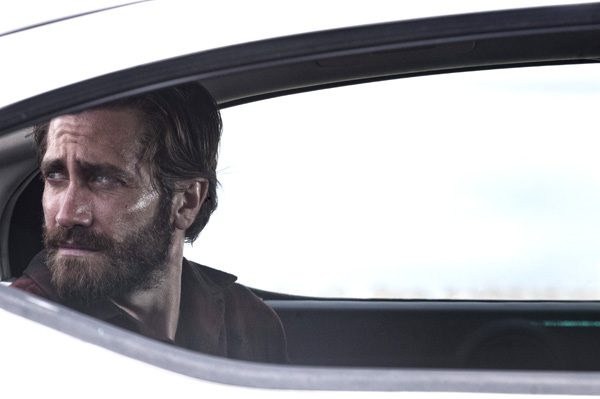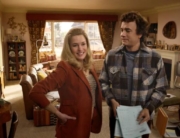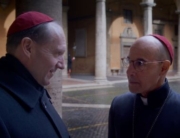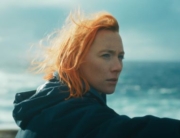Hands down, the title sequence of Tom Ford’s narrative smash-up is one of the most visually arresting and sensational in recent memory. To say more would likely ruin its intended in-your-face shock value, though many might find it a heavy-handed attention-grabber. The slow-motion opener is Ford’s introductory salvo, the first trick (or gimmick) out of his filmmaking tool bag, though it has little to do with the twisted (in more ways than one) storylines or the movie’s grab bag of themes.
This adaptation of Austin Wright’s 1993 novel Tony and Susan presents a mishmash of styles, from hothouse drama to cool, elegant, and elliptical European art house. From its first frame, substance is buffed and polished, and compositions are fussily arranged, lest a single strand of star Amy Adams’s hair falls out of place. Though composer Abel Korzeniowski’s pseudo-Bernard Hermann score swoons and yearns, the film’s not really a thriller, though it has the trappings of one.
The main story centers on Susan Morrow (Adams), up close and personal, with the camera zeroing in on her blue eyes. An art-world wheeler-dealer, she lives in a concrete fortress up in the Hollywood Hills. She and her husband, Hutton (Armie Hammer), live such a rarefied existence that they can’t perform everyday household functions without drama: she cuts her finger opening a package that arrives unexpectedly in the night, which turns out to be from her ex-husband, Edward, whom she hasn’t seen in 19 years. It’s a manuscript entitled Nocturnal Animals, the moniker of which, singular, was his nickname for his night-owl ex-wife. (Susan still has trouble sleeping, though you would never know it from the lavish close-ups.)
Hubby Hutton’s away for a last-minute business meeting in Manhattan and the staff has been given the weekend off, so Susan settles in for an unsettling read of her ex’s novel: a tale of revenge and challenged machismo on a lonely West Texas highway. But is the book-to-be, the plot of which wouldn’t be out of place in a 1970s movie of the week, more than a bloody and pulpy thriller? Could it be the literary equivalent of Marvin Gaye’s 1978 album Here, My Dear, a bitter retort to an ex-wife? Susan reads on.
Jake Gyllenhaal plays Edward in flashbacks as well as the tight-lipped everyman of the film-within-the-film, Tony Hastings, who’s underseiged as a gang of local thugs run his car off the side of a road and kidnap his wife and teenage daughter. (Think Deliverance, but on land.) In an otherwise well-cast film, British actor Aaron Taylor-Johnson plays one of back road baddies, chewing and spitting out scenery like it was stale tobacco.
A permeating sense of threat and regret ooze from one story to the other, tying the narratives together. You never know whether the next shot is going to be a Southwestern sunset or Susan, filmed voyeuristically as a solitary figure in her dimly-lit mausoleum of a home.
Perhaps no other film this year calls such attention to its editing as Animals (the equally violent High-Rise is a close second). In some ways, the edits are too obvious, too choreographed, as though sequences were made for a film school assignment. There’s the traumatized Tony, on one side of the screen, lying in a hotel bed with his eyes wide open. The shot dissolves to Susan, on the opposite side of the frame, also unable to sleep. Or a bloody Tony takes a shower, followed by Susan doing the same in the next shot. If movie musicals were all about the transitions from song to dialogue and back again, then Ford would be a natural in that genre.
The editing, though, holds the film together even as it wildly wavers from the sinister to the silly. Laura Linney looks as though she stepped out of a William Hamilton New Yorker cartoon, perfectly coiffed in a 1960s bouffant—though the scene is set circa 1990—and wearing Chanel and pearls as Susan’s tell-it-like-it-is WASP-ish mother, Anne Sutton. The art direction goes over-the-top, too, in an only-in-the-movies way: one of the Texas thugs has a toilet right on his back porch. Likewise, a nearly unrecognizable Andrea Riseborough makes a briefly appearance as Susan’s confidant, incongruously behaving and looking like a cast member of Laugh-In.
Though the role of the introverted and calculating Susan restrains Adams’s natural radiance, she’s never less than convincing. However, the script’s back-and-forth chronology of Susan’s relationship with Edward, interwoven with Tony’s tragic circumstances, omits one crucial piece of the puzzle: a moment when Susan and Edward are happy as a couple. Going back in time, the former high school friends first reunite by accident on a crowded New York City street as young graduate students and then flirt during an impromptu dinner. But the first sign of trouble occurs right away when Susan’s mother delivers a Cassandra-type warning that Edward is “too weak” for her daughter and that the two have different outlooks. We see the rise and the sudden fall of their relationship, but not the pinnacle. Though the film looks sleek overall, it could use some filler, which is perhaps why it left some colleagues at the Toronto International Film Festival cold. (That, and perhaps how Ford alternates between directing with a heavy and light hand.)
This all-out exercise of contrasting styles is something of a bait and switch on the part of the director. The tone—reflected in everything from the score to the brutality inflicted upon the Hastings family—will lead viewers to expect a propulsive conclusion, when the film is, instead, a somber contemplation of a midlife crisis. Anne’s admonition that “we all eventually turn into our mothers” turns out to be true for Susan, but the film fortunately leaves much open-ended. (Not everything is announced with an eyebrow arched.)
I was among the disappointed camp after the first viewing, but I found the film to be seductive the second time around, knowing that it doesn’t deliver on all its teases. It was a much different experience after I took the advice of Susan’s friend, an art world raconteur played by Michael Sheen, who advises her to, “Enjoy the absurdity of our world.”








Leave A Comment